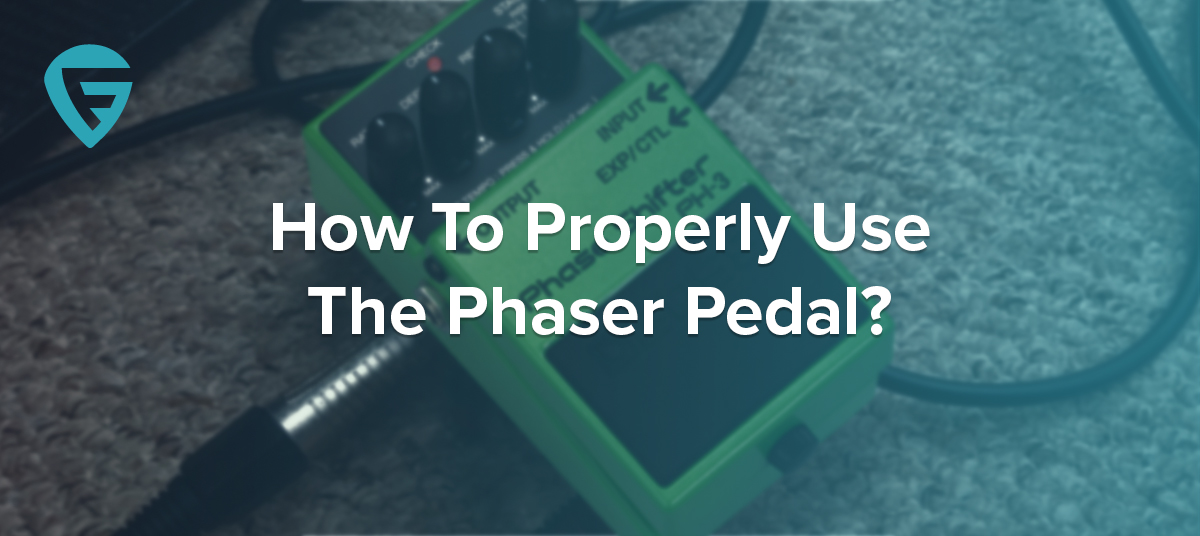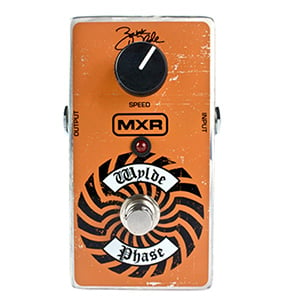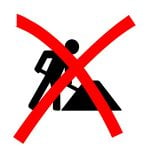- Home
- Instruments
- Gear
- Recording
- Lessons
- Reviews
- Blog

Modulation pedals in general add a whole new dimension of versatility to your tone, there's no question about that. With that said, they are among the hardest pedals to work with as well. If you have had any prior experience with any type of modulation pedal, you will know that moderation is the key. Actually, in some cases, not even that is enough. We won't go into detail about other pedals, but we will try to give you a right idea about how to best use the Phaser pedal in your signal chain.
Before we begin, we need to add a word of caution. What we are going to show you today is not some holy rule that is set in stone. On the contrary, it's only a decent foundation that you can later use to explore your Phaser pedal in a way that won't damage your tone. If nothing else, you should be able to recognize what is it that you did that made your guitar sound horrible. With that said, let's jump right in.
 We have already covered how Phasers work in our dedicated article you can find here ‘What Is a Phaser Effect?', but let's do a quick recap for the sake of brevity.. A Phaser pedal will split the signal into two, and apply a series of all pass filters to one of the copies. The two signals are pushed thru simultaneously, resulting in them being completely out of phase at times, and completely in phase at other times. When the former happens, you will hear a dip in your tone, and when the latter happens you get to hear a spike. Understanding this is important since the controls on just about any Phaser pedal will allow you to influence when these dips and spikes occur, which directly impacts the clarity of your tone.
We have already covered how Phasers work in our dedicated article you can find here ‘What Is a Phaser Effect?', but let's do a quick recap for the sake of brevity.. A Phaser pedal will split the signal into two, and apply a series of all pass filters to one of the copies. The two signals are pushed thru simultaneously, resulting in them being completely out of phase at times, and completely in phase at other times. When the former happens, you will hear a dip in your tone, and when the latter happens you get to hear a spike. Understanding this is important since the controls on just about any Phaser pedal will allow you to influence when these dips and spikes occur, which directly impacts the clarity of your tone.
 The answer is, very badly. While it doesn't really affect the signal from the guitar in a sense that it distorts it in any way, a Phaser still changes it in different ways. Adding more ‘Speed' using the knob that usually comes with the same title, will increase the number of the dips you hear in the tone. More dips equals less signal integrity. With Phasers, it's very easy to lose yourself in the effect, and start applying too much Speed and Resonance. That is a big no-no if you want to have a useable tone at the end of the day. With that said, how you're going to set up your Phaser pedal will depend on the type of music you're playing as well.
The answer is, very badly. While it doesn't really affect the signal from the guitar in a sense that it distorts it in any way, a Phaser still changes it in different ways. Adding more ‘Speed' using the knob that usually comes with the same title, will increase the number of the dips you hear in the tone. More dips equals less signal integrity. With Phasers, it's very easy to lose yourself in the effect, and start applying too much Speed and Resonance. That is a big no-no if you want to have a useable tone at the end of the day. With that said, how you're going to set up your Phaser pedal will depend on the type of music you're playing as well.
 Phasers can be used in virtually any genre of music if you're creative enough. With that said, there are genres where it fits in a lot better than in others. For example, classic rock is standard Phaser territory. You will understand why in a minute. Technical death metal is probably not going to be a genre where you would want to use a Phaser pedal. Naturally, different pedals have different intended purpose, so it's best to check out what's currently recommended and go from there.
Phasers can be used in virtually any genre of music if you're creative enough. With that said, there are genres where it fits in a lot better than in others. For example, classic rock is standard Phaser territory. You will understand why in a minute. Technical death metal is probably not going to be a genre where you would want to use a Phaser pedal. Naturally, different pedals have different intended purpose, so it's best to check out what's currently recommended and go from there.
 How you will use the Phaser depends on your playing style as well. It's a known fact that Phasers generally work the best when you are playing few notes at a slower tempo. For example, slow chord arpeggios work great with this effect as it gives the pedal enough time to work every not you've played. Shredding a fast solo is the complete opposite. In theory, any slow part that isn't too saturated with notes, will benefit from a properly setup Phaser effect. It works even better if you are on a clean channel instead of an overdrive or distortion.
How you will use the Phaser depends on your playing style as well. It's a known fact that Phasers generally work the best when you are playing few notes at a slower tempo. For example, slow chord arpeggios work great with this effect as it gives the pedal enough time to work every not you've played. Shredding a fast solo is the complete opposite. In theory, any slow part that isn't too saturated with notes, will benefit from a properly setup Phaser effect. It works even better if you are on a clean channel instead of an overdrive or distortion.
One of the major mistakes many new users of this effect make, is to crank everything up to 11 as soon as they unpack the pedal. First thing that happens is complete degradation of the signal, which then leads the user to thing that there's something wrong with the pedal. End result is mostly complete abandoning of the pedal, and regret that it was bought in the first place. Don't fall victim to this bad practice, and approach your Phaser pedal with a bit of caution.
 Like we have mentioned before, anything that is played at a faster tempo and includes a lot of notes is just going to be held back by a Phaser. Heavy distortions generally don't work well with Phasers, although overdrives are completely fine if you use moderation. At the end of the day, it all comes down to how well you can work your Phaser, and how good you are at matching the osculation of the signal with the tempo of your music. All of these things come with experience and a lot of trial and error. Phasers are definitely not the type of effect you can nor want to master over night.
Like we have mentioned before, anything that is played at a faster tempo and includes a lot of notes is just going to be held back by a Phaser. Heavy distortions generally don't work well with Phasers, although overdrives are completely fine if you use moderation. At the end of the day, it all comes down to how well you can work your Phaser, and how good you are at matching the osculation of the signal with the tempo of your music. All of these things come with experience and a lot of trial and error. Phasers are definitely not the type of effect you can nor want to master over night.
Phasers are an important part of the modulation effects family, and they have played a key role in numerous popular songs. It's not an easiest effect to use, there's no doubt about that, but mastering it is very gratifying.to say the least. If you are looking for a new effect to explore, you should definitely give the Phaser a fair chance.

Reader Interactions